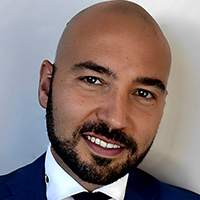When he was 4 years old, Angelo D’Alessandro clearly recalls a cartoon book about the peripatetic nature of red blood cells. Their adventures traveling through the body, visiting the brain, kidneys, lungs, liver, et al., mesmerized D’Alessandro in his native Italy.
“My mom was reading these books and one day she was so fed up with me asking to read more, she was like, ‘If you like it so much, just read it yourself.’ And I did,” recalls D’Alessandro, PhD, professor in the Department of Biochemistry and Molecular Genetics at the University of Colorado School of Medicine. “And then I ended up working on red blood cells 20 years later.”
Listen to the podcast:
In the intervening years, D’Alessandro became much more interested in what’s inside red blood cells than their outward circulatory habits. While his research has taken him in many directions, it focuses largely on advancing personalized medicine. In a recent study, D’Alessandro and his collaborators posited that stored red blood cells, under current practices, which haven’t changed much for the last 100 years, are not always safe to transfuse due to donor, time and processing factors.
And what’s inside that stored blood is especially important. “The blood donor populations provide a window on the span of physiology, all the declinations of physiology, as it is defined by genetic and non-genetic factors,” D’Alessandro said. “The genetic cards that you’ve been dealt at birth versus how much you exercise versus your exposures (smoking, alcohol intake, et al.).”
D’Alessandro said lab-on-a-chip technology could be used to assess the quality and metabolic signatures of stored red blood cells, allowing the units to be tailored to the needs of recipients – sickle cell or cancer patients, for example, or trauma patients who need a high-volume transfusion.
Advancing the technologies and strategies around red blood storage is just another tool in the growing personalized-medicine toolbox. “I think that, to some extent, the future of personalized medicine is already here.”
In the podcast, D’Alessandro also talks about the importance of cross-pollinating his research with other scientists across the CU Anschutz Medical Campus.
“This campus has been an extremely collaborative environment for our lab,” D’Alessandro said. “I’m honored I get a chance to learn from a lot of smarter colleagues that work in their respective fields. We learn something from one field that could be useful for another field, right?”




